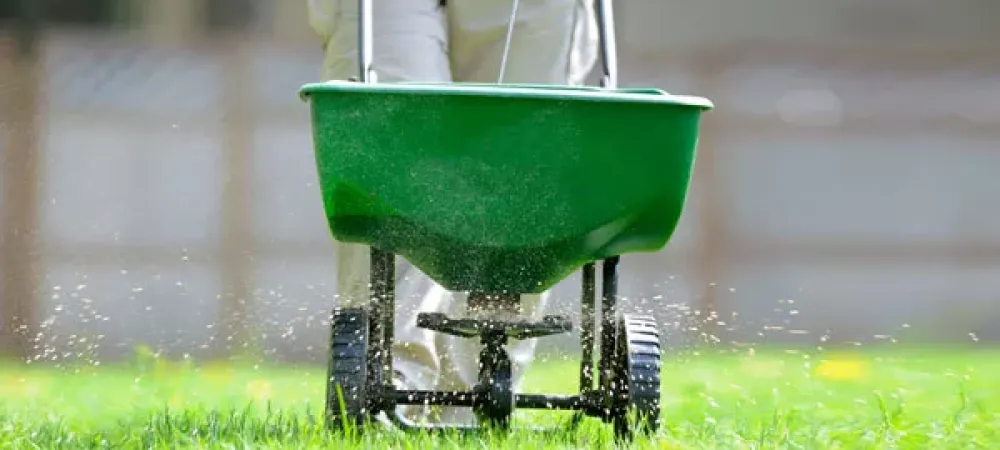What is Overseeding?

Overseeding is a lawn care service that involves the distribution of additional grass seed onto an existing lawn. This is done to promote the growth of new grass plants in areas where the existing grass may be thinning, damaged, or not as healthy as desired. The primary purpose of overseeding is to improve the density and coverage of grass in the lawn, making it look more lush and uniform. It's a proactive measure to address common lawn issues such as wear and tear from foot traffic, disease, pests, and environmental stress.
By spreading fresh grass seed over the existing turf, overseeding helps fill in any gaps or bare spots, resulting in a fuller, healthier lawn. This process is commonly used to maintain the quality of the grass and restore its visual appeal, especially in areas where the grass has become sparse or less vibrant over time. Overseeding is an essential practice for homeowners and landscapers looking to rejuvenate their lawns and maintain a vibrant, green appearance.
What is The Purpose of Overseeding?
The primary purpose of overseeding is to improve the overall quality and appearance of a lawn by promoting the growth of new grass plants alongside existing ones. The purpose of overseeding is:
- Thickening the Lawn: Over time, lawns can develop thin or bare areas due to factors such as heavy foot traffic, disease, pests, drought, or environmental stress. Overseeding helps fill in these gaps, making the lawn denser and more uniform.
- Enhancing Grass Health: By introducing new grass plants, overseeding can rejuvenate and revitalize a lawn that may be struggling due to factors like aging, damage, or disease. This promotes a healthier and more resilient turf.
- Weed Suppression: A thicker lawn can naturally suppress weed growth by limiting the available space for weeds to establish themselves. Overseeding is an effective method to reduce weed infestations without resorting to chemical treatments.
- Disease and Pest Resistance: A dense and healthy lawn is better equipped to resist disease and pest infestations, reducing the need for chemical interventions and promoting a more eco-friendly approach to lawn care.
- Aesthetic Improvement: Overseeding results in a more vibrant, lush, and uniform lawn, which can significantly enhance the overall appearance of your property. It increases curb appeal and property value.
When is the Best Time to Overseed?
The timing of overseeding is critical for its success. The best time to overseed largely depends on your climate and the type of grass you have. Generally, overseeding is most effective during the early fall or spring, as these seasons provide the optimal conditions for grass seed germination and growth. Cool-season grasses, like Kentucky bluegrass and fescue, thrive when overseeded in the fall, while warm-season grasses, such as Bermuda or Zoysia, benefit from spring overseeding.
Should you Mow Before or After Overseeding?
Mowing your lawn before overseeding is generally recommended. Here's how to tackle mowing your lawn before overseeding:
- Lower the Mower Height: Before overseeding, set your lawn mower to a lower cutting height than usual. This will help expose more of the soil and create an ideal environment for the new grass seed to come into contact with the soil.
- Mow the Existing Grass: Give your lawn a thorough mowing to trim the existing grass to a shorter height. Be sure not to scalp the lawn, which means cutting it too short. You should remove no more than one-third of the grass blade's height in a single mowing session.
- Remove Grass Clippings: After mowing, remove the grass clippings from the lawn, as they can create a barrier between the new grass seed and the soil.
Now it’s time to overseed:
- Select the Right Seed: Choose the appropriate grass seed for your region and lawn type. High-quality grass seed is essential for successful overseeding.
- Evenly Spread Seed: Use a broadcast spreader or a handheld spreader to evenly distribute the grass seed over the lawn. Ensure uniform coverage to achieve consistent results.
After Overseeding:
- Water Thoroughly: After overseeding, water the lawn thoroughly to help the new grass seed make good contact with the soil and initiate germination. Keep the soil consistently moist during the establishment period.
- Avoid Mowing Immediately: Do not mow your lawn immediately after overseeding. Allow the new grass to establish itself, which usually takes a few weeks.
- Resume Regular Mowing: Once the new grass has reached a height of at least 3 inches, you can resume regular mowing. Gradually raise the mower height to your desired level.
